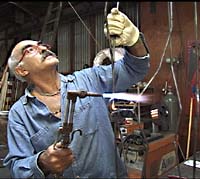Dream Sequence 2
Phase one: The idea
 |
People from all over the world have done film and video pieces on Burning Man, trying to show it in all of its random glory. Burning Man has become an icon on the desktop of modern culture, something that a growing segment of an alienated alternative society can point to and say, "That's me ... that's what I like." Burning Man is many things to many people: an art festival, a social experiment, a place where the rules of modern life are relaxed enough to allow something more primal and human to surface. It's ... unique.
In many ways, it's a filmmaker's paradise. Wherever you point your camera, there's something interesting, or at least colorful. But I had yet to see a film that really focused on the people of Burning Man and why this event keeps growing. It seemed to me that attempts at documenting the event had missed the point by getting caught up in the intensely visual aspects of it.
I'd seen the opera once before. In 1997, I'd been asked by another director who was doing a film about Burning Man to shoot the opera from within the performance, a rarely seen perspective. That year's opera was called The Daughters of Ishtar, based on an ancient Sumerian text. Pepe didn't mind me or my DV camera, so long as I was naked and painted blue.
Running through the huge set, which was mostly on fire, with hundreds of other naked and screaming "Mesopotamians," while trying to hold my camera steady was by far the most surreal shooting experience I had ever had. As I lay in my tent that night, replaying what I had shot in the viewfinder of my camera, the images looked like the dream of an ancient god.
The idea of these operas fascinated me over the course of the next several months. I wanted to know what went into the making of them. What was it that drove these people into investing months of their time, with no pay, to create and act out a unique ritual that few would understand, only to destroy it in the end? What sort of spiritual transformation would they undergo? And who was in this culture that lived below the surface of contemporary society? People with a need to experience some kind of pure ritual, people from all walks of life with a need to live, if just for a short while, in someplace other than a dot-com world?
So I proposed an idea to Pepe. I wanted to shoot a documentary about the creation and performance of the opera as a window into this other society, this "chaos culture." I wanted to show the "why" of Burning Man, instead of the "what." I wanted to show that people still performed unrequited acts of great meaning and beauty with an informed, intelligent madness, simply because it felt good. I wanted to shoot this thing.
Pepe looked at me cautiously and said, "OK."